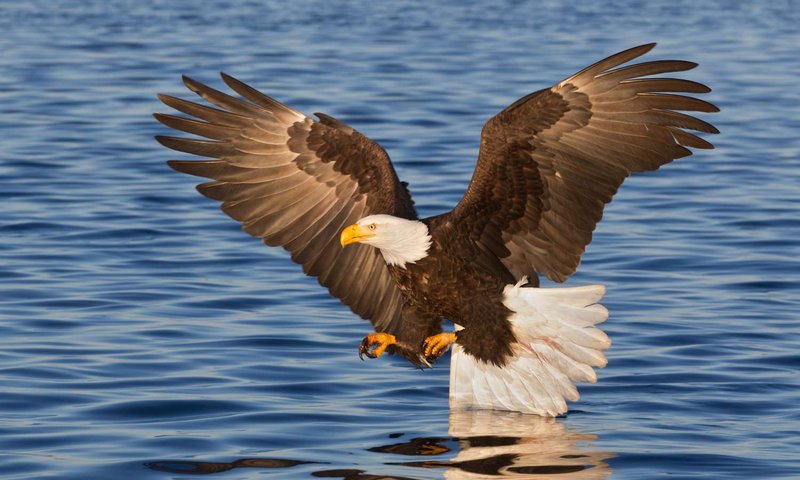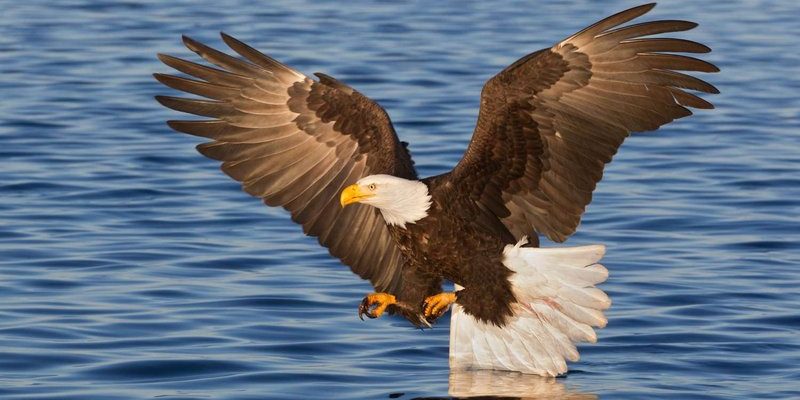
Imagine a creature that can spot a rabbit from several miles away, or one that can carry off a fish nearly as heavy as itself. The bald eagle is not just a beautiful sight; it’s a master of the skies. Whether you’re a birdwatching enthusiast or just curious about wildlife, the bald eagle has a lot to teach us about nature’s resilience and adaptability.
1. A Symbol of Strength and Freedom
The bald eagle has long been a symbol of strength and freedom in the United States. Officially adopted as the national bird in 1782, it represents courage and independence. This majestic bird has been woven into the fabric of American culture, appearing on coins, emblems, and official seals. Seeing a bald eagle in flight often stirs feelings of pride and patriotism.
But what makes them so special? Beyond their striking appearance, bald eagles are powerful hunters with a keen sense of sight, allowing them to spot prey from up to three miles away. This ability, paired with their strong talons and powerful wings, makes them top hunters in their habitat.
2. Unique Features and Appearance
Bald eagles are easy to recognize due to their distinctive white head and tail, contrasting with their dark brown body and wings. Interestingly, they don’t always look like this. Young bald eagles, under four years old, have a completely brown plumage. It takes them a few years to develop their iconic white feathers.
Their beaks are large and hooked, perfect for tearing into their catch, whether it’s fish or smaller birds. Adult bald eagles can reach a wingspan of about 6 to 7.5 feet, making them one of the largest birds in North America. You might be wondering, how do these features affect their survival? Well, their sharp beaks and strong talons are essential for hunting and defending their territory.
3. Diet: Fish and Beyond
While most people think of bald eagles as fish-eaters, they actually have quite a varied diet. They primarily hunt fish, thanks to their incredible fishing skills, but they also eat small mammals, birds, and even carrion. This flexibility in diet helps them thrive in various environments.
When hunting, bald eagles can dive down at speeds up to 100 miles per hour, using their talons to catch fish mid-air. Here’s a fun fact: they can consume nearly a pound of food in one sitting! If you ever see a bald eagle perched near a river or lake, chances are it’s scouting for its next meal.
4. Nesting Habits and Family Life
Bald eagles are known for their impressive nests, which can be up to 13 feet deep and 8 feet wide, making them some of the largest nests of any bird. They typically build their nests near water, as it allows quick access to food. Both parents are involved in raising their young, often producing one to three eggs each breeding season.
The incubation period lasts about 35 days, and once the chicks hatch, they are altricial, meaning they are born helpless and depend entirely on their parents for food and protection. It’s fascinating to see how the parents work together to feed and teach their young to fly and hunt. As they grow, they become more independent, but they often stay near their parents for up to a year.
5. Thriving Population Recovery
In the mid-20th century, bald eagles faced a steep decline due to habitat loss and the use of pesticides like DDT. Their population dropped to dangerously low numbers, prompting conservation efforts. It’s inspiring to see how these efforts have paid off.
Thanks to protections like the Bald and Golden Eagle Protection Act and recovery programs, their numbers have rebounded significantly. In 2007, bald eagles were removed from the endangered species list, a true testament to the power of conservation.
6. Migratory Behavior
Bald eagles are not strictly migratory, but their movements can depend on their habitat. In colder regions, they often migrate south to find open water and food during winter. Other eagles, particularly those living in warmer areas, may stay put year-round.
When migrating, bald eagles can travel hundreds of miles in search of better living conditions. This adaptability shows just how resilient these birds can be, ensuring their survival even in changing environments.
7. Unforgettable Mating Rituals
Bald eagles typically mate for life, forming strong bonds with their partners. Their courtship includes impressive aerial displays—like soaring high, locking talons mid-air, and tumbling together before breaking apart. These rituals help strengthen their bond and ensure compatibility.
Once paired, they work together to build and maintain their nests, showcasing their teamwork throughout the breeding season. This commitment to one another is a beautiful aspect of their behavior, highlighting the importance of partnership in raising their young.
8. Conservation Status and Ongoing Threats
Despite their population recovery, bald eagles still face threats from habitat destruction, lead poisoning from ingesting spent ammunition, and climate change. Human activities continue to impact their habitats, so ongoing conservation efforts remain crucial.
Organizations are working hard to mitigate these threats by promoting safe practices, like lead-free fishing gear and protecting nesting sites. Raising awareness about the ongoing challenges bald eagles face is essential for ensuring their future.
9. Cultural Significance and Myths
Beyond being a national symbol, bald eagles have deep cultural significance for many Native American tribes. They are often viewed as spiritual messengers, and their feathers are used in ceremonies, symbolizing honor and bravery.
In various myths, bald eagles are portrayed as powerful figures, representing strength and vision. It’s fascinating how one bird can hold such diverse meanings across different cultures, weaving it into human history and storytelling.
10. Fun Facts You Didn’t Know
You might be surprised by some of these fun facts about bald eagles:
- They can live up to 20-30 years in the wild, but some in captivity have lived longer.
- Bald eagles have an average weight of 3 to 6.3 kg (6.6 to 14 lbs) depending on the region.
- They can see four to five times better than humans, which enhances their hunting skills.
- Their nests can weigh over a ton, built from sticks, grass, and other materials.
These little tidbits just add to the wonder of the bald eagle, showcasing how unique and remarkable they are.
In conclusion, bald eagles are more than just a beautiful bird gliding through the sky. They represent resilience, strength, and the power of nature. Understanding their behavior, habitat, and the challenges they face can help us appreciate these magnificent creatures even more. The next time you see a bald eagle, take a moment to reflect on its incredible story and what it symbolizes for so many.

